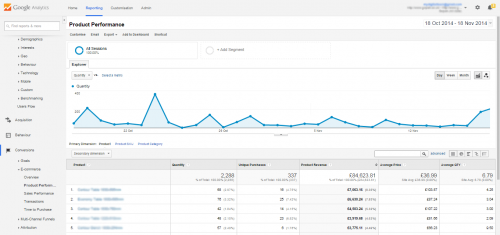The Fastest Way to Increase eCommerce SEO Sales
Now when you think “fastest”, SEO wouldn’t usually jump out at you – search engine optimisation isn't usually synonymous with high speed.
However, if you have an established eCommerce website with existing top 20 rankings, then eCommerce SEO does offer the fastest way to increase your eCommerce sales without needing to pour PPC (pay per click) media spend in or come up with clever CRO (conversion rate optimisation) tests.
To increase your eCommerce SEO revenue (maybe as soon as by tomorrow), just follow these steps:
1. Dive into Analytics
Go straight to your website analytics and find your highest revenue driving products from SEO already (last month of data is ideal).

If using Google Analytics:
- Go to: Conversions > eCommerce > Product Performance
- Segment the data to “Organic Search” only (Add Segment above, delete “All”)
- Sort “Product Revenue” to highest to lowest to find your top performing products from SEO
- Sort by “Unique purchases” to see the most popular products
- Then try a different tack, and go to: Behaviour > Site Content > Landing Pages
- Sort by “Conversion rate” to see which landing pages convert at the highest rates
The higher the amount of revenue the products drive, the sooner you’ll hit your sales targets.
The more popular the products you’re targeting the greater the number of likely purchases.
The higher the conversion rate of that landing page (category or product), the fewer the number of people you need to get to that page to get a sale.
2. Search results analysis
Now you want to cross-reference the insights you have on your top performing category and product pages with where you already rank in the search results. The big opportunities will be keywords you are already ranking for, where there are a high volume of impressions and that you have a low click through rate. Amending your meta data copy will increase your ranking and increase click through to send you more relevant traffic straight away.
If using Google Webmaster Tools:
- Go to: Search Traffic > Search Queries
- Sort by “Impressions” to see the search queries your site appears in the search results most often for
- Then analyse the “Average position” column to find keywords that you are already on page 1 or 2 for (positions 2-20, if you’re 1 already, great job, your work there is done… for now)
- Make a list of all the keywords you appear in the top 20 for
- Then changing tack again, sort the list by “click through rate”
- Make a list of the keywords that get above average click through rates and appear in the top 20. This means you already have great meta data including title tag and meta description. Go and review the title tags and meta descriptions for those pages to analyse why they are getting clicked on and use those insights to inform your meta data copywriting for the pages that could be improved.
3. Landing page analysis
Now you’ve found a list of juicy pages ripe for improvement, you’re looking for gaps to squeeze some extra optimisation out of it.
But be careful, as you don’t want to remove any existing keywords you’re already ranking for as you won’t be ranking for them much longer.
The purpose of this stage is to add in new keywords and buyer focused copy into the gaps, whilst keeping all the existing keywords you already have.
- What keywords are already contained in the meta data? If you’re not sure, check the page title, by right clicking to view source and looking at the content contained in between the title tags (the word title with a < on the left and a > on the right)
- Does the title tag make full use of the 58 characters available to display in search results or are there gaps to add in more keywords?
- Does the meta description include a call to action and keywords variations?
- Does the landing page header include the target keywords?
- Does the landing page sub headers include keyword variations?
- Does the landing page content contain all possible keyword variations like USPs, colour, size and style?
- Does the page have internal links linking to it from onsite blogs and advice guides?
So that 3 step process is the fastest way to increase eCommerce sales using eCommerce SEO.
Follow my contributions to the blog to find out more about eCommerce SEO or sign up to the ThoughtShift Guest List, our monthly email, to keep up-to-date on all our blogposts, guides and events.

